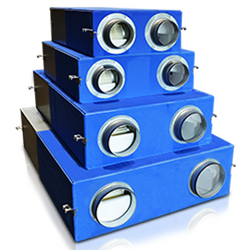
Heat recovery ventilation enables the exchange of air in rooms without the risk of contamination and odors penetrating into the supply air. The main task of the heat recovery ventilation system is to provide the house with fresh, filtered air heated by the exhaust air and remove (extract) stale, "polluted" air.
Energy recovery units are not only characterized by heat recovery function, thanks to the advanced technology of the enthalpy (counterflow) exchanger they recover heat and moisture from the air.
The spacing between the cellulose fibers allows free passage of water vapour molecules. Thus, larger molecules, like those of odours, cannot pass through the heat exchanger. This prevents the contamination of the fresh air supplied indoors. Moreover, the energy efficiency of heat recovery units reaches (depending on the model) from 250 to 1000 m3/h.
Instead of a standard heat exchanger, an enthalpy exchanger is used, which transforms the unit into an Energy Recovery Ventilation (ERV) system, as opposed to a standard Heat Recovery Ventilation (HRV) system. Meaning both thermal and latent energy from the stale air is extracted from wet rooms.
An enthalpy exchanger is an air-to-air heat exchanger that additionally transfers moisture from one stream to another. The so-called latent energy, which reduces the energy demand for air conditioning.
Energy recovery ventilators are recommended for cold and warm climates. In moderate climates, the client can choose between heat and enthalpy exchangers, taking into account its advantages. At the design stage, it is difficult to determine whether there will be a problem with too dry air, often the decision to buy an enthalpy exchanger is made after 1-2 years of using the heat recovery system.
Advantages of an energy recovery ventilator